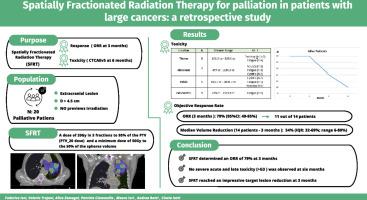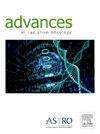Spatially Fractionated Radiation Therapy for Palliation in Patients With Large Cancers: A Retrospective Study
IF 2.2
Q3 ONCOLOGY
引用次数: 0
Abstract
Purpose
Spatially fractionated radiation therapy (SFRT) is an irradiation technique developed to improve large cancer response. Although preliminary studies report highly positive results, data are still limited. The aim of this retrospective monocentric study was to investigate SFRT safety and activity.
Methods and Materials
We analyzed all patients who underwent SFRT as a palliative treatment for large solid extracranial cancer (>4.5 cm) at our institution. The primary endpoint was objective response rate assessment at 3 months. Additionally, patients’ antalgic response, target volume reduction, and performance status modification were measured. Toxicity data were recorded.
Results
From November 2021 to August 2023, 20 consecutive patients (20 lesions) underwent SFRT. We prescribed a minimum dose of 20 Gy in 5 fractions to 95% of the Planning Target Volume (PTV_20) and a minimum dose of 50 Gy to 50% of the sphere volume. The median beam-on time was 5 minutes (IQR1-3, 4-7 minutes; range, 3-16 minutes). Patients’ median age was 70 years (range, 18-85 years). The median lesion volume was 560.4 cm3 (IQR1-3, 297.4-931.5 cc; range, 168.3-3838.3 cm3). Of the 20 patients, 14 and 10 were alive at 3 and 6 months, respectively. The 3-month objective response rate was 79% (95% CI, 49%-95%), with a median target volume reduction of 54% (IQR1-3, 32%-69%; range, 6%-80%). At 6 months, all patients were free from local disease progression. All patients reported an antalgic response with a rapid onset. All treatment-related toxicities occurred within 1 month after SFRT and quickly recovered. No acute toxicity ≥ grade 3 and late toxicity was reported. No patient experienced a worsening in performance status.
Conclusions
Our results provide further evidence supporting SFRT as a safe and promising option for palliative patients affected by large neoplastic lesions.

空间分割放疗对大肿瘤患者的缓解作用:一项回顾性研究
目的:分步放射治疗(SFRT)是一种用于改善大肿瘤反应的放射治疗技术。虽然初步研究报告了非常积极的结果,但数据仍然有限。这项回顾性单中心研究的目的是调查SFRT的安全性和活动性。方法和材料我们分析了我院所有接受SFRT作为大实体性颅外癌(>4.5 cm)姑息治疗的患者。主要终点是3个月时的客观缓解率评估。此外,还测量了患者的镇痛反应、靶体积缩小和运动状态改变。记录毒性数据。结果从2021年11月至2023年8月,连续20例患者(20个病变)接受了SFRT。我们规定的最小剂量为20 Gy,分5份,达到计划目标体积(PTV_20)的95%,最小剂量为50 Gy,达到球体体积的50%。中位照射时间为5分钟(IQR1-3、4-7分钟;范围,3-16分钟)。患者中位年龄为70岁(范围18-85岁)。中位病灶体积为560.4 cm3 (IQR1-3, 297.4-931.5 cc;范围:168.3-3838.3 cm3)。在20例患者中,分别有14例和10例在3个月和6个月时存活。3个月客观缓解率为79% (95% CI, 49%-95%),中位目标体积减少54% (IQR1-3, 32%-69%;范围内,6% - -80%)。6个月时,所有患者均无局部疾病进展。所有患者均报告有快速发作的止痛反应。所有治疗相关的毒性均发生在SFRT后1个月内,并迅速恢复。无急性毒性≥3级及晚期毒性报道。无患者表现恶化。结论我们的研究结果进一步证明了SFRT作为一种安全且有希望的姑息治疗方案用于大肿瘤病变患者。
本文章由计算机程序翻译,如有差异,请以英文原文为准。
求助全文
约1分钟内获得全文
求助全文
来源期刊

Advances in Radiation Oncology
Medicine-Radiology, Nuclear Medicine and Imaging
CiteScore
4.60
自引率
4.30%
发文量
208
审稿时长
98 days
期刊介绍:
The purpose of Advances is to provide information for clinicians who use radiation therapy by publishing: Clinical trial reports and reanalyses. Basic science original reports. Manuscripts examining health services research, comparative and cost effectiveness research, and systematic reviews. Case reports documenting unusual problems and solutions. High quality multi and single institutional series, as well as other novel retrospective hypothesis generating series. Timely critical reviews on important topics in radiation oncology, such as side effects. Articles reporting the natural history of disease and patterns of failure, particularly as they relate to treatment volume delineation. Articles on safety and quality in radiation therapy. Essays on clinical experience. Articles on practice transformation in radiation oncology, in particular: Aspects of health policy that may impact the future practice of radiation oncology. How information technology, such as data analytics and systems innovations, will change radiation oncology practice. Articles on imaging as they relate to radiation therapy treatment.
 求助内容:
求助内容: 应助结果提醒方式:
应助结果提醒方式:


